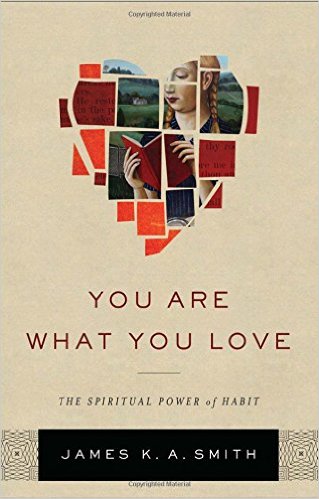 In part 1 of the series, we explored how it’s not what we cognitively believe that directs us but what has captures our love and imagination. As Christians, we know the right answers for what we should love: Jesus, His Kingdom, etc. The problem is that this often doesn’t match reality.
In part 1 of the series, we explored how it’s not what we cognitively believe that directs us but what has captures our love and imagination. As Christians, we know the right answers for what we should love: Jesus, His Kingdom, etc. The problem is that this often doesn’t match reality.
Smith argues that what we truly love is “manifested by [our] daily life and habits” (29). Put simply, we have habits of behavior that reinforce or change what we love, how we view the world, and how we behave despite the fact that we’re often completely unaware that they are affecting us. The “formative practices that do something to you, unconsciously” (37) Smith calls “liturgies” because of how they wrap the practitioner into an (alternative) ultimate story with rival visions of obtaining the good life.
The Christian must recognize the liturgies in which we engage in order to break their power. Smith concludes this chapter with an important point that, “not all sins are decisions” (54). To make this point I’ll provide an analogy. Imagine your spouse went out and got hammered drunk. After being sufficiently inebriated they cheated on you. Under their state of drunkenness they were not making decisions and you know they would never soberly decide to cheat. Are they still guilty of cheating? Of course, they placed themselves in a state that produced infidelity. Even if they didn’t choose (as we often consider it) to cheat, they are responsible and bear the guilt of cheating. In the same way, when we choose to live under the influence of this world’s liturgies, we are still responsible for the heart patterns and actions that instinctively result.
Case Study:
To demonstrate how seemingly neutral events can be loaded with religious symbols that can affect us, Smith gives a case study of a mundane trip to the mall.
You enter the mall and are struck by the high ceilings speaking of the transcendent nature of the event. The skylight windows suggest the place as a gateway to heaven and the lighting makes you feel that time stands still as you are removed from the “real world” for a bit. You have been driven here by the prophets who declare through television commercials (and the shows themselves), billboards, and advertisements that the broken nature of your life will be made complete through the purchase of an item. The testimonies are seen by the happy, at rest faces of the practitioners. The temple (i.e. mall) is especially busy at this time as we approach another in its unending holidays and festivals, that call to both faithful and nominal participants to up their participation. As we wander the labyrinth we see the iconography in posters and mannequins that give us a window into the good life. We enter one and pick out something that will better our life and meet a priest whom we leave a token in exchange for this piece of the good life. Leaving the temple we find a sense of fulfillment and hope that we have perhaps found something that will help.
While it may not be possible to avoid the mall or all advertising, this case study helps illustrate how our lives are immersed in a counter-narrative to the gospel. One that mis-identifies our major problem and offers a false salvation. Nothing in the practice tries to convince you intellectually that consumerism will really satisfy, but they all work on your heart. We therefore need to examine what narratives and liturgies we are letting work on our heart.
What does this have to do with Family Discipleship?
If you’re like most families, you’re incredibly busy running to and fro with different activities. Many of our activities we view as morally neutral activities but they may or may not be having tremendous impact on the vision we produce in our children.
Some questions to ponder and discuss with your spouse:
- Do you think Smith has a point about how we are practicing liturgies that change our loves? Why or why not?
- What liturgies exist in our culture? What are they suggesting about what humanity’s main problem is and what is our “salvation”? What are the temples of these liturgies and the associated icons and hopes that work on our hearts (we saw the mall was one in the case study)?
- What liturgies could we be practicing as a family that are proclaiming false gospels?
- Hospitality in a Covid World - December 17, 2020
- Jesus, the Liberator We Don’t Want - June 12, 2020
- Why I’m NOT an Inerrantist - June 11, 2020



